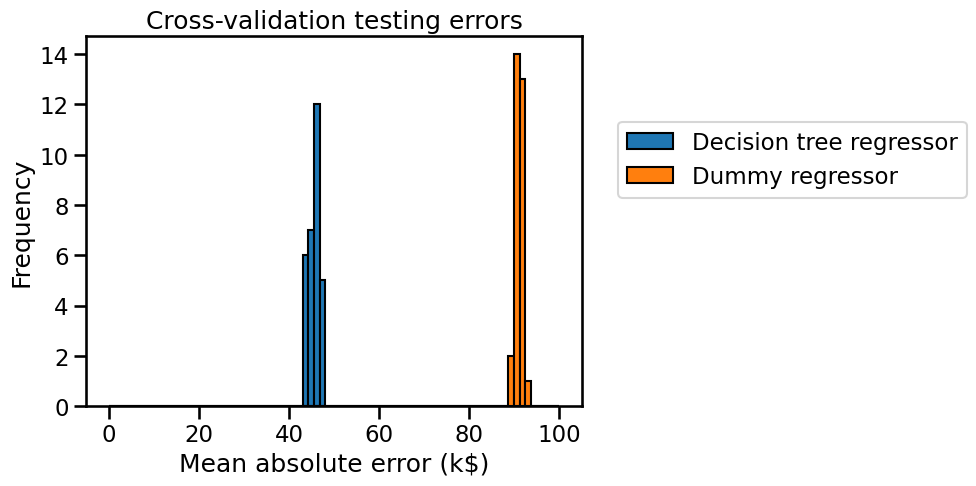Comparing model performance with a simple baseline#
In this notebook, we present how to compare the generalization performance of
a model to a minimal baseline. In regression, we can use the DummyRegressor
class to predict the mean target value observed on the training set without
using the input features.
We now demonstrate how to compute the score of a regression model and then compare it to such a baseline on the California housing dataset.
Note
If you want a deeper overview regarding this dataset, you can refer to the section named “Appendix - Datasets description” at the end of this MOOC.
from sklearn.datasets import fetch_california_housing
data, target = fetch_california_housing(return_X_y=True, as_frame=True)
target *= 100 # rescale the target in k$
Across all evaluations, we will use a ShuffleSplit cross-validation splitter
with 20% of the data held on the validation side of the split.
from sklearn.model_selection import ShuffleSplit
cv = ShuffleSplit(n_splits=30, test_size=0.2, random_state=0)
We start by running the cross-validation for a simple decision tree regressor which is our model of interest. Besides, we will store the testing error in a pandas series to make it easier to plot the results.
import pandas as pd
from sklearn.tree import DecisionTreeRegressor
from sklearn.model_selection import cross_validate
regressor = DecisionTreeRegressor()
cv_results_tree_regressor = cross_validate(
regressor, data, target, cv=cv, scoring="neg_mean_absolute_error", n_jobs=2
)
errors_tree_regressor = pd.Series(
-cv_results_tree_regressor["test_score"], name="Decision tree regressor"
)
errors_tree_regressor.describe()
count 30.000000
mean 45.663756
std 1.214956
min 43.682669
25% 44.796011
50% 45.753914
75% 46.558999
max 47.997163
Name: Decision tree regressor, dtype: float64
Then, we evaluate our baseline. This baseline is called a dummy regressor.
This dummy regressor will always predict the mean target computed on the
training target variable. Therefore, the dummy regressor does not use any
information from the input features stored in the dataframe named data.
from sklearn.dummy import DummyRegressor
dummy = DummyRegressor(strategy="mean")
result_dummy = cross_validate(
dummy, data, target, cv=cv, scoring="neg_mean_absolute_error", n_jobs=2
)
errors_dummy_regressor = pd.Series(
-result_dummy["test_score"], name="Dummy regressor"
)
errors_dummy_regressor.describe()
count 30.000000
mean 91.140009
std 0.821140
min 89.757566
25% 90.543652
50% 91.034555
75% 91.979007
max 92.477244
Name: Dummy regressor, dtype: float64
We now plot the cross-validation testing errors for the mean target baseline and the actual decision tree regressor.
all_errors = pd.concat(
[errors_tree_regressor, errors_dummy_regressor],
axis=1,
)
all_errors
| Decision tree regressor | Dummy regressor | |
|---|---|---|
| 0 | 46.252221 | 90.713153 |
| 1 | 47.122262 | 90.539353 |
| 2 | 44.230612 | 91.941912 |
| 3 | 43.731460 | 90.213912 |
| 4 | 47.997163 | 92.015862 |
| 5 | 45.170314 | 90.542490 |
| 6 | 43.955949 | 89.757566 |
| 7 | 44.450599 | 92.477244 |
| 8 | 44.940107 | 90.947952 |
| 9 | 44.747979 | 91.991373 |
| 10 | 47.008742 | 92.023571 |
| 11 | 45.803452 | 90.556965 |
| 12 | 45.093547 | 91.539567 |
| 13 | 45.811914 | 91.185225 |
| 14 | 46.741463 | 92.298971 |
| 15 | 43.885867 | 91.084639 |
| 16 | 45.971291 | 90.984471 |
| 17 | 46.504399 | 89.981744 |
| 18 | 45.142408 | 90.547140 |
| 19 | 46.980128 | 89.820219 |
| 20 | 43.682669 | 91.768721 |
| 21 | 46.315907 | 92.305556 |
| 22 | 45.704375 | 90.503017 |
| 23 | 46.577199 | 92.147974 |
| 24 | 46.648009 | 91.386320 |
| 25 | 45.691297 | 90.815660 |
| 26 | 44.139437 | 92.216574 |
| 27 | 46.302171 | 90.107460 |
| 28 | 45.439936 | 90.620318 |
| 29 | 47.869812 | 91.165331 |
import matplotlib.pyplot as plt
import numpy as np
bins = np.linspace(start=0, stop=100, num=80)
all_errors.plot.hist(bins=bins, edgecolor="black")
plt.legend(bbox_to_anchor=(1.05, 0.8), loc="upper left")
plt.xlabel("Mean absolute error (k$)")
_ = plt.title("Cross-validation testing errors")

We see that the generalization performance of our decision tree is far from being perfect: the price predictions are off by more than 45,000 US dollars on average. However it is much better than the mean price baseline. So this confirms that it is possible to predict the housing price much better by using a model that takes into account the values of the input features (housing location, size, neighborhood income…). Such a model makes more informed predictions and approximately divides the error rate by a factor of 2 compared to the baseline that ignores the input features.
Note that here we used the mean price as the baseline prediction. We could have used the median instead. See the online documentation of the sklearn.dummy.DummyRegressor class for other options. For this particular example, using the mean instead of the median does not make much of a difference but this could have been the case for dataset with extreme outliers.

